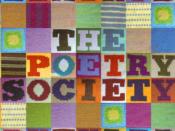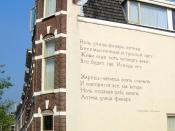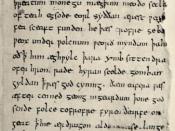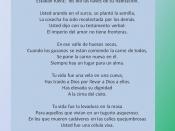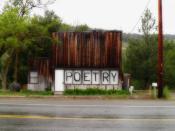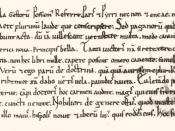Daniel Lombardo Viewing the Body Viewing the Body by W.D. Snodgrass is a poem that mixes the story of a boring and soulless life with rhythm, bright colors, and emotions which make the woman in the poem seem that much more boring and wasteful of life.
The poem discusses the funeral of a woman and how she is presented in her funeral as someone people would be more likely to romanticize than what she actually was, perhaps out of a misguided sign of respect. The other more hidden meaning behind the poem is the author's reaction to the women herself and how she is portrayed in almost a spiteful, angry way because of his anger over her wasting her life in gray dullness.
To amplify how plain she was he fills the poem with many vibrant and strong words such as colors and strong language. Starting from the first paragraph he mentions flowers and eye shadow, which are both colorful and alive.
He uses the words gangster and whore, which are both strong personalities in life that movies and books have been written about because of their unique lifestyle.
The second paragraph continues with this use of lively words by mentioning lipstick a very bright and with some people their most distinguishing characteristic. The other keyword was the dress she was wearing which apparently she never would have worn in life suggests it's either revealing or extravagant in some way. The phrase "clothes makes the man"ÃÂ also applies especially for women. For the last several hundred years women have always been very particular with what they where, portraying their social class, their independence, and their moods. Something that has been deemed so important to the female gender for so long is definitely something that this woman could have taken advantage of in life but did not, and now in death she is forced into this culture.
The third paragraph is packed with keywords starting with the very first sentence comparing her to a gray mouse. It's difficult to think of a better way to portray a boring person than by using the color gray. Calling her a mouse is also significant because it portrays a quiet, small creature that is at the mercy of almost everything and can never stand up for itself in the wake of trouble. The next line adds information as to how she lived her life, apparently living with her mother till her death, and sleeping alone under the covers lets us assume that she was never married, or possibly ever in love. Two more words that really stand out in this paragraph are the "dark"ÃÂ halls and the "dim"ÃÂ bedcovers. These choice words continue the gray imagery that portrays her life so well.
The final paragraph combines three vivid words in a row "obscene red folds of satin"ÃÂ. Red and obscene definitely go well together, it being the color of blood and notorious for its sexual undertones, definitely a color that the woman would have avoided during life. The last word that grabs attention is the satin that lines the inside of the coffin. Satin is one of the most soft and smooth materials that is both comfortable and attractive as well as a sign of wealth and extravagance. This is a most ironic way to be spending an eternity of death in such lively and extravagant surroundings after a life spent working so hard to avoid anything that makes life worth living.
The actual structure of this poem is very strict having four paragraphs with four lines each. I think this is yet another way of portraying her life as very simple, very regimented, and structured. The content of the paragraphs are filled with things that go against the gray mouse theme. Examples of this as mentioned before are paragraphs saturated with key words that stand out with color or action. The other strange issue about the structure of the poem is that punctuation is almost used at leisure. In some sentences he uses proper punctuation then he will omit a period, or capitalize a word halfway through a sentence.
This disorganization and use of lively terms trapped inside of such a strict poem structure may have many meanings. The two seemingly more obvious conclusions are that by putting so much movement and color in the mist of a poem that is structured like her life is a way for the author to show his disapproval at the way she has lived her life. He openly puts things that she would find objectionable in a poem about herself.
The second conclusion is that maybe he's showing what was really going on inside her head as opposed to what everyone saw on the outside. The structure being very formal representing her external appearance and the passion and chaos was inside of her hidden from the rest of the world under her firm shell.
It's hard to decide what the poem is really about because of these two very different possible solutions. The one message that can be derived from this poem is not to waste your life being meek and gray. You have the rest of existence to do that in your grave.
